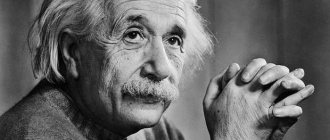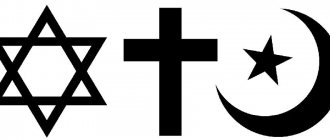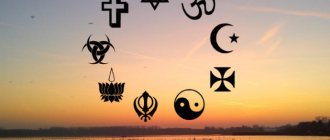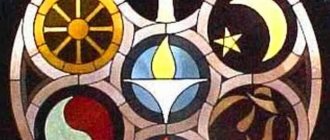(from Lat. religio - “shrine”, piety, piety; Cicero associated it with Lat. religere - to collect, revere, observe, reconsider). A special form of awareness of the world, conditioned by belief in the supernatural, which includes a set of moral norms and types of behavior, rituals, religious activities and the unification of people in organizations (church, religious community). American anthropologist C. Geertz, exploring the “cultural aspect of the analysis of religion,” also defines it as a system of symbols, “which contributes to the emergence in people of strong, comprehensive and stable moods and motivations, forming ideas about the general order of existence and giving these ideas have an aura of reality in such a way that these moods and motivations seem to be the only real ones.” At the same time, theologians argue that no matter how comprehensive the definition of religion is, a non-believer is not able to understand and define its essence.
Also on topic:
BUDDHA AND BUDDHISM
Theology (the doctrine of God) is a system of dogma that appears with the emergence of theistic religions (Judaism, Christianity and Islam) and social institutions of the Jewish or Muslim community or the Christian church.
Christian theology is divided into historical, which explores the history of the Church and the Bible; systematic – dogmatics, apologetics; practical - homiletics, catechetics, liturgics (teachings about worship). Theology continues to develop to the present day. Cm.
BECK, LEO; BART, CARL; CONGAR, IV; WELTE, BERNHARD; LONERGAN, BERNARD; RUNNER, CARL; BENEDICT XVI.
How did religion originate?
RELIGION is the same age as humanity. In any case, archaeologists and anthropologists think so. Even in the most primitive, undeveloped civilizations, signs of one form or another of religiosity are observed. In the New Encyclopedia Britannica it is true that Fr.
Religion is distinguished not only by its age, but also by its diversity. Headhunters in the jungles of Borneo, Eskimos in the ice of the Arctic, nomads of the African Sahara, residents of huge megacities - every people on earth has their own god or gods, as well as their own understanding of how to worship them. One can only shrug when looking at this diversity.
A logical question arises: where are the origins of all these religions? They are so different, but at the same time so similar that you can’t help but wonder: did they appear independently of each other or do they originate from some single proto-religion? And why did religion arise in the first place? And How? If we want to know the truth about faith and religion, we cannot neglect these issues.
Perception difficulties
It's hard to imagine this connection when you no longer need to kill anyone to survive, and you buy meat from the store packaged and already without bones. This is even more difficult to understand in modern hunting, where you stand hundreds of meters from the animal and pull the trigger. And this is not about qualifications or convenience. It's about empathy. We lack emotions because we are already very far from our origins.
Where to look for its roots
When talking about the emergence of religion, people, depending on their religion, remember Buddha, Confucius, Muhammad or Christ. In almost all religions one can find some central figure who gave rise to the “true faith.” Some were brave reformers, some were moral philosophers, and some were selfless folk heroes. Many of these people left behind writings or traditions that became the foundation of a new religion. Over time, their words and actions were rethought, embellished and shrouded in an aura of mystery. Some leaders were literally deified.
Although these individuals are considered the founders of famous religions, they cannot be said to have founded a religion as such. More often than not, the teachings of religious leaders emerged from the cradle of pre-existing religious ideas, even if most of them claimed to be divinely inspired. Or they simply reformed and modified religious systems that did not suit them in some way.
For example, according to historical data, the Indian prince, who later became the Buddha, was once shocked by the contemplation of the suffering that overwhelmed Hindu society. He began to look for solutions to the problems that plagued life, and this led to the emergence of Buddhism. Muhammad was also outraged by the idolatry and immorality that he saw in the religious practices of his contemporaries. He later announced that he had received revelations from God that formed the basis of the Koran, which became the holy book of a new religious movement - Islam. As for Protestantism, it spun off from Catholicism during the Reformation, which began in the first quarter of the 16th century. At that time, Martin Luther opposed the trade in indulgences carried out by the Catholic Church.
So, today there is enough information about the emergence and development of existing religions, about their founders, sacred texts and the like. But what can be said about the religions that preceded them? And about those that were even earlier? As we delve further into history, sooner or later we will ask the question: how did religion arise? To answer this, we will have to go beyond individual religions.
Judaism
Judaism is the oldest Abrahamic faith, originating in ancient Israel. The Torah becomes the foundational scripture and part of a larger text known as the Tanakh or Hebrew Bible. It is supplemented by traditions set down in written form in later texts such as the Midrash and Talmud. Judaism includes a vast body of scriptures, practices, theological positions, and forms of organization. There are many movements in this religion, most of which came out of Rabbinic Judaism, which proclaims that God revealed his laws and commandments to Moses on Mount Sinai in the form of inscriptions on stones, and in oral form - the Torah. Historically, this claim has been disputed by various scientific groups. The largest Jewish religious movements are Orthodox Judaism (Haredi), Conservative and Reform.
The hypotheses are endless.
The origin and development of religion is a relatively new area of knowledge. For centuries, people have more or less accepted the religious traditions familiar from childhood. Usually they were content with the stories of their fathers and grandfathers, who considered their religion to be an immutable truth. It never occurred to people to doubt anything or try to find out how, when and why this or that custom arose. Due to limited freedom of movement and a narrow social circle, not many people even knew that there were any other religions on earth.
However, in the 19th century the situation began to change. The theory of evolution has captured the minds of the intelligentsia. With the advent of the era of scientific discoveries, people began to question everything, including religion. Some scientists have come to the conclusion that by studying modern religions, one still cannot get to the bottom of their origins. Therefore, they switched to studying the monuments of ancient civilizations or went to remote corners of the world where people still lived in primitive communities. Armed with the methodologies of various scientific disciplines - psychology, sociology, anthropology - they began to attack the questions of how religion arose and why.
What did this lead to? Scientists came up with a whole series of discordant theories, competing with each other in the boldness and extravagance of their conclusions. Moreover, there were, perhaps, no fewer theories than there were researchers themselves. Some have derived valuable propositions; the efforts of others have faded into oblivion. A brief overview of their research will be educational and will help to better understand the religious views of our contemporaries.
The English anthropologist Edward Tylor (1832-1917) put forward the so-called theory of animism. He suggested that dreams, visions, hallucinations and the lifelessness of dead bodies led primitive people to the conclusion that a soul (Latin anima) lived in their body. Since they often dreamed of deceased relatives, they, according to this theory, thought that the soul continues to live after death: it leaves the body and moves into trees, rocks, streams and the like. As a result, people began to deify the dead and those objects into which, in their opinion, souls moved. This is how religion came into being, according to Tylor.
Another English anthropologist, Robert Marett (1866-1943), modified Tylor's theory and proposed his own version, which became known as the theory of animatism. Having studied the beliefs of the Melanesians living on the Pacific Islands and the indigenous populations of Africa and America, Marett came to the conclusion that primitive people had no concept of the human soul. They rather believed in some impersonal or supernatural force that animates everything. Such faith aroused in man a feeling of awe and fear, which became the basis of his primitive religion. According to Marett, religion appeared primarily as a person’s emotional reaction to the unknown. Marett liked to say that religion “is not so much invented as danced.”
In 1890, Scottish ethnographer-folklorist James Fraser (1854-1941) published his famous book The Golden Bough, in which he stated that religion owes its origin to magic. According to Fraser, in the beginning, man tried to influence his life and the world around him by imitating what he saw in nature. For example, a person thought that if he sprinkled water on the ground while drums were roaring (imitating a thunderstorm), he could make it rain, and if he pricked the image of his enemy with thorns, he could be damaged. This is how rituals, spells and magical objects became widespread. When they did not act, man, instead of subjugating higher powers, tried to come to an amicable agreement with them and cajoled them in every possible way. Spells and rituals were transformed into prayers and sacrifices - and thus religion arose. Fraser himself explained: “By religion I mean the propitiation and pacification of powers higher than man.”
Even the famous Austrian psychoanalyst Sigmund Freud (1856-1939) tried to explain the origin of religion in his book “Totem and Taboo”. True to his craft, Freud argued that religion emerged from the so-called father complex. In his opinion, just as in herds of wild horses and bulls, in the human “primitive horde” the leader was the father. His sons both hated him and admired him. To seize the father's power, Freud said, these savages "joined together, killed and ate the father." However, later remorse forced them to come up with various rituals and ceremonies to atone for their guilt. According to Freudian theory, the father figure became God, rites and ceremonies became the primary religion, and eating the murdered father became a communion tradition practiced by many religions.
These, of course, are not all the theories that have been used to explain the origin of religion. Many of them were forgotten forever. But even those that remain cannot be called indisputable and reliably substantiated. They were simply not confirmed by any historical facts or evidence. They were just a figment of the researchers’ imagination, hypotheses that quickly replaced one another.
Stereotheism and polytheism
How purely theoretical non-literate stereotheism relates to the polytheisms (pagan systems) known to us from the first written language is a question for future research. One thing is clear. Ancient stereotheism gave rise to polytheisms. This may have occurred as a result of ancient globalization within the empire-like ancient civilizations of the major rivers (Indus, Tigris and Euphrates, Nile). Divine pairs were called differently in different societies, and when united into an empire, a multiplication of local stereotheistic pairs occurred.
False premise - erroneous conclusion
After many years of desperate efforts to understand how religion arose, many decided for themselves that this issue would remain a secret behind seven seals. Firstly, because bones and other fossil remains cannot tell us what ancient people thought about, what they were afraid of and what prompted them to bow to higher powers. Any conclusions that are drawn from these findings are hypotheses at best. Secondly, the religious beliefs of so-called primitive people living today (for example, the Aborigines of Australia) cannot be considered a reliable indicator of what our ancestors thought and how they behaved. No one knows exactly how human culture has changed over the centuries.
Therefore, in the book “Religions of the World: From Antiquity to Modernity” the following conclusion is made: “The modern historian of religion knows that it is impossible to find out the origin of religion.” And regarding attempts to do this, the author of the book notes: “In those years, theorists for the most part were concerned not so much with the description or explanation of religion as with its desacralization. They understood that if you prove that early forms of religion are based on illusions, then you can undermine the foundations of later and developed religions” (Parrinder G. World Religions—From Ancient History to the Present).
This apt observation shows why various "scientific" studies into the origins of religion have not yielded satisfactory results. Logic dictates that you can come to the right conclusions only by building on the right foundation. If you start from a false premise, there is little chance of coming to the right conclusions. Since pundits have not given an intelligible explanation of the origin of religion, serious doubts arise about the fundamental basis of their reasoning. Guided by a preconceived opinion and discrediting religion in every way, they, in essence, led to the conclusion that there is no God.
A similar situation existed until the 16th century in astronomy. There have been many theories of planetary motion, but none have been satisfactory. Why? Because they all proceeded from the position that the Earth is the center of the Universe and all the stars and planets revolve around it. There was no real progress and there could not be until scientists - and the church - accepted the fact that the Earth is not the center of the Universe, that it revolves around the Sun, the center of the solar system. Since numerous theories failed to explain the obvious facts, unbiased minds decided to reconsider the basis of their contemporary understanding of the world, rather than invent yet another theory. And it was a success.
The same principle applies to research into the origins of religion. The theory of evolution and atheism became popular in the world, and many people accepted as an axiom that there is no God. Based on this, they began to look for an explanation for the existence of religion in man himself - in his thoughts, needs, fears, complexes. Seizing on Voltaire's statement: “If God did not exist, he would have to be invented,” they declared that God was invented by man.
Since many theories have not led to the desired result, maybe it's time to re-examine the foundation on which they are based? Maybe instead of going in circles, we should look elsewhere for answers? Preconceptions aside, the fresh approach may turn out to be quite sound and scientific. Let's look at one example.
Fetishism
It is impossible to consider primitive religions without taking into account fetishism. It represented the belief that some things have supernatural properties. Various objects were worshiped, passed from parents to children, always kept at hand, and so on.
Fetishism is often compared to magic. However, if it is present, it is in a more complex form. Magic helped to have an additional impact on some phenomenon, but did not in any way influence its occurrence.
Another feature of fetishism is that the objects were not worshipped. They were revered and treated with respect.
Any modern religion can be considered descendants of fetishism, since everywhere there are certain objects that help to establish a connection with God. These are icons, crosses, crescents, holy relics, amulets and so on.
The Quest of the Ancients
In the 1st century AD e. The Greek city of Athens was a famous scientific center. Many philosophical schools were formed there, for example, Epicurean and Stoic, each with its own ideas about deities. Therefore, in Athens there were many cults of various gods. Naturally, the city was full of man-made idols and temples.
Around 50 AD. e. A Christian missionary, the Apostle Paul, arrived in Athens. What he began to teach the Athenians was a wonder for them. Paul said: “God, who created the world and all that is in it, He, the Lord of heaven and earth, does not live in temples made with hands, and human hands do not serve him, as if he needed anything, because he himself gives to everyone life and breath and everything” (Acts 17:24, 25).
In other words, Paul made it clear to the Athenians that the true God, “who created the world and everything in it,” is not a figment of the imagination and cannot be pleased with invented rituals. True religion is not just an attempt by a person to satisfy some psychological need or drown out fear. Since the true God is the Creator who gave humans reason, it is logical that he would leave them the opportunity for much-needed communication with himself. According to Paul, God did just that. “From one man he created every nation of men to dwell upon all the face of the earth... that they might seek God, lest they should sense him and find him, although he is not far from each of us” (Acts 17:26, 27).
Notice the key point in Paul's words: "From one man he [God] created every nation of men." Although there are many peoples living on earth, scientists have come to the conclusion that they all come from the same family. This is a very important point, because if people have a common origin, it means that they are related not only biologically and genetically. They still have a lot in common.
It’s interesting what the book A World History of Religious Practice says about human languages: “Scholars who have studied and compared the languages of the peoples of the world have concluded that they are all divided into groups and families and have their origins from the same source.” World's Worship). In other words, languages did not appear separately and independently of each other, as evolutionists would like to believe, who suggest that cavemen in different parts of the earth - Africa, Europe and Asia - were first explained by moos and growls, but eventually spoke different human languages . Everything suggests that languages “have their origins from a single source.”
If this is true of language—an integral part of human culture and life—then would it not be reasonable to assume that human ideas about God and religion must also have a common source? After all, religion is associated with thinking, and thinking is associated with speech abilities. It is not that all religions originate from one religion, but rather that they must be traced back to some source from which religious ideas and beliefs are drawn. Is there any evidence for this? And if religions really have a common origin, then what? And how do you find out about this?
Islam
Islam is based on the Koran, the holy book about the Prophet Muhammad, described as a major political and religious figure who lived in the seventh century AD. Islam is based on the fundamental unity of religious philosophies and accepts all the prophets of Judaism, Christianity and other Abrahamic faiths. It is the most widely practiced religion in Southeast Asia, North Africa, West Asia, and Central Asia, and there are also Muslim majorities in parts of South Asia, sub-Saharan Africa, and Southeast Europe. There are several Islamic republics - Iran, Pakistan, Mauritania and Afghanistan.
Islam is divided into the following interpretations:
- — Sunni Islam is the largest denomination in Islam;
- — Shia Islam is the second largest;
- - Ahmadiyya.
There are Muslim revivalist movements such as Muwahidism and Salafism.
Other denominations of Islam include: Nation of Islam, Sufism, Quranism, non-denominational Muslims and Wahhabism, which is the dominant Muslim school in the Kingdom of Saudi Arabia.
Different but similar
We can find answers to our questions in the same way that linguists find the answer to the question of the origin of languages. By comparing languages with each other, etymologists can establish their kinship and determine their origins. So we, by comparing religions - their structure, doctrines, legends, rituals, foundations - can see whether they are connected by a common thread, and if so, where this thread leads.
At first glance, many religions today are noticeably different from each other. However, if we put aside obvious embellishments and later additions, as well as differences that arose under the influence of climate, language, geography and other factors, we can note a rather curious similarity between them.
Take, for example, Catholicism and Buddhism - religions of the West and East. So seemingly different! But what is revealed if we discard the cultural and linguistic layers? If you look without prejudice, you can see that there is a lot in common between them. Both religions use rituals and ceremonies that include candles, incense, holy water, rosaries, images of saints, chants, prayer books and even the symbol of the cross. Both religions traditionally maintain monasteries and monasteries and are well known for the special robes of priests, their vows of celibacy, holidays and dietary restrictions. This is by no means a complete list, but it is enough to make one wonder: why do two religions, so far apart from each other, have so much in common?
No less interesting is the comparison of other religions. It turns out that there are beliefs that are common to almost all religions. Most of us have heard about the immortality of the human soul, about reward in heaven for the good or eternal torment in the underworld for the evil, about purgatory, about the three- or multi-hypostatic god, about the Mother of God or the queen of heaven. There are many other legends and myths that are similar to each other. For example, about how man, through his sinful attempt to achieve immortality, brought upon himself the disfavor of God, about the need to make sacrifices to atone for sin, about the search for the tree of life or the fountain of youth. Also legends about gods and demigods who lived among people and gave birth to giants, and about the Flood, which destroyed almost all of humanity from the earth.
What conclusion can be drawn from this? It is impossible not to notice that the peoples who have preserved these legends to this day live far from each other. They differ greatly in their culture, customs, and way of life. And yet their religions have much in common. Although not all nations have all the legends listed above, they all have at least some of them. A reasonable question arises: why? The main religious views - to a greater or lesser extent - seemed to be drawn from the same source. Over time, these basic ideas were modified and embellished, so that new teachings were born from them. However, their common features are obvious.
It is logical to conclude that the similarity of basic concepts in many religions of the world is proof that they did not arise in isolation and independently of each other. Their beliefs must rather have a common basis in the distant past. What could it be?
Unpopular primitive religious beliefs
The types of primitive religions need to be supplemented with some beliefs that are not as popular as totemism or, for example, magic. These include the agricultural cult. Primitive people who practiced agriculture worshiped the gods of various cultures, as well as the earth itself. There were, for example, patrons of corn, beans, and so on.
The agricultural cult is well represented in modern Christianity. Here the Mother of God is represented as the patroness of bread, George - of agriculture, the prophet Elijah - of rain and thunder, and so on.
Thus, it will not be possible to briefly consider the primitive forms of religion. Every ancient belief exists to this day, even if it has actually lost its face. Rituals and sacraments, rituals and amulets - all these are parts of the faith of primitive man. And it is impossible in modern times to find a religion that does not have a strong direct connection with the most ancient cults.
The crisis of monotheism
With the development of international trade and financial markets, monotheism began to weaken, as strict monotheistic moral standards and a patriarchal traditionalist family structure began to interfere with the enrichment of the rapidly growing economically and politically international bourgeoisie.
The capital that was earned from usury, piracy, the slave trade and the exploitation of colonies began to be invested in the fight against monotheistic religions. As a result, such broad social movements as the Renaissance (Revival of paganism, neo-paganism), Freemasonry, occultism, Kabbalah and atheism arose.










